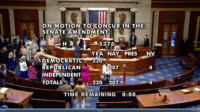Thanks to a burst of late June activity by the House Appropriations Committee, the first batch of fiscal year 2023 spending bills was nearing a House floor vote by the week of July 18. The package of six bills to be voted on includes measures covering key Dept. of Transportation, Environmental Protection Agency and military construction programs. Based on the bills’ totals as they emerged from committee, the numbers show a mix of increases and cuts for construction programs compared with funding levels enacted for 2022.
The House committee’s bill funding DOT would provide a 2% hike for the Federal Highway Administration’s highway obligation limit, a critically important account. For public transportation, the Federal Transit Administration (FTA) formula grants account would edge up by less than 1%. FTA’s Capital Investment Grants account would jump 34%, to $3 billion, including $2.1 billion for new transit starts.
Looking at the House panel bill’s DOT numbers, Brian Turmail, Associated General Contractors of America vice president of public affairs and strategic initiatives, says, “The biggest takeaway ... was how [lawmakers] are proposing to freeze the large discretionary grant funding and instead significantly increase the amount that goes into earmarks, compared to what they did in the House last year.”
For example, under the bill, DOT’s popular Rebuilding American Infrastructure with Sustainability and Equity (RAISE) competitive infrastructure grant program would be frozen at 2022’s $775-million level. Since the program’s creation more than a decade ago, it has regularly attracted requests for far more grant dollars than DOT had available.
Examples of transportation earmarks can be found in a line item for highway infrastructure programs, which draws on the general fund, not the Highway Trust Fund. The committee provided $1.76 billion for that account, including $1.28 billion for earmarks. Among aviation programs, an airport grants-in-aid account, which taps the general fund, would more than double, to $554 million. All of the year-over-year increase of $227 million would go toward earmarked projects.
Winners among non-DOT programs in the committee bills include General Services Administration’s federal buildings construction and acquisition, which would more than triple, and GSA’s buildings renovations, with a 66% boost.
The U.S. Army Corps of Engineers civil works program would receive a 7% hike, but within that, the Corps’ construction account was trimmed slightly.
John Doyle, special counsel with law and lobbying firm Jones Walker LLP, says the bill has strong funding for coastal construction projects, but he calls the amount for inland waterway projects “terribly disappointing,” at $88.6 million.
EPA’s water infrastructure program would see a 19% increase. But appropriators also included $934 million for earmarked projects.
Still to come is 2023 appropriations action in the Senate. Jay Hansen, National Asphalt Pavement Association executive vice president for advocacy, says the Senate will provide another opportunity for 2023 funding boosts for infrastructure. But he cautions, “Don’t count your chickens until the eggs hatch.”
Stopgaps Ahead
In recent years, Congress has been unable to pass spending bills before the fiscal year’s Oct. 1 start. That has led lawmakers to fall back on stopgap continuing resolutions, or CRs, to avert government shutdowns.
This fall’s legislative schedule faces a tighter squeeze from the Nov. 8 elections and pre-election campaigning. That makes a stopgap a likely bet. Doyle predicts “a CR at the end of September that will carry things over until after the election.” Turmail agrees with that forecast, but says, “The real question is whether they set [the CR] to expire in November or early December.” He says a second stopgap is possible, too. Turmail adds, “An absolute worst case would be if Congress needs to pass a third one that takes us into Christmas or even 2023—that would be less likely but definitely unfortunate.”







Post a comment to this article
Report Abusive Comment